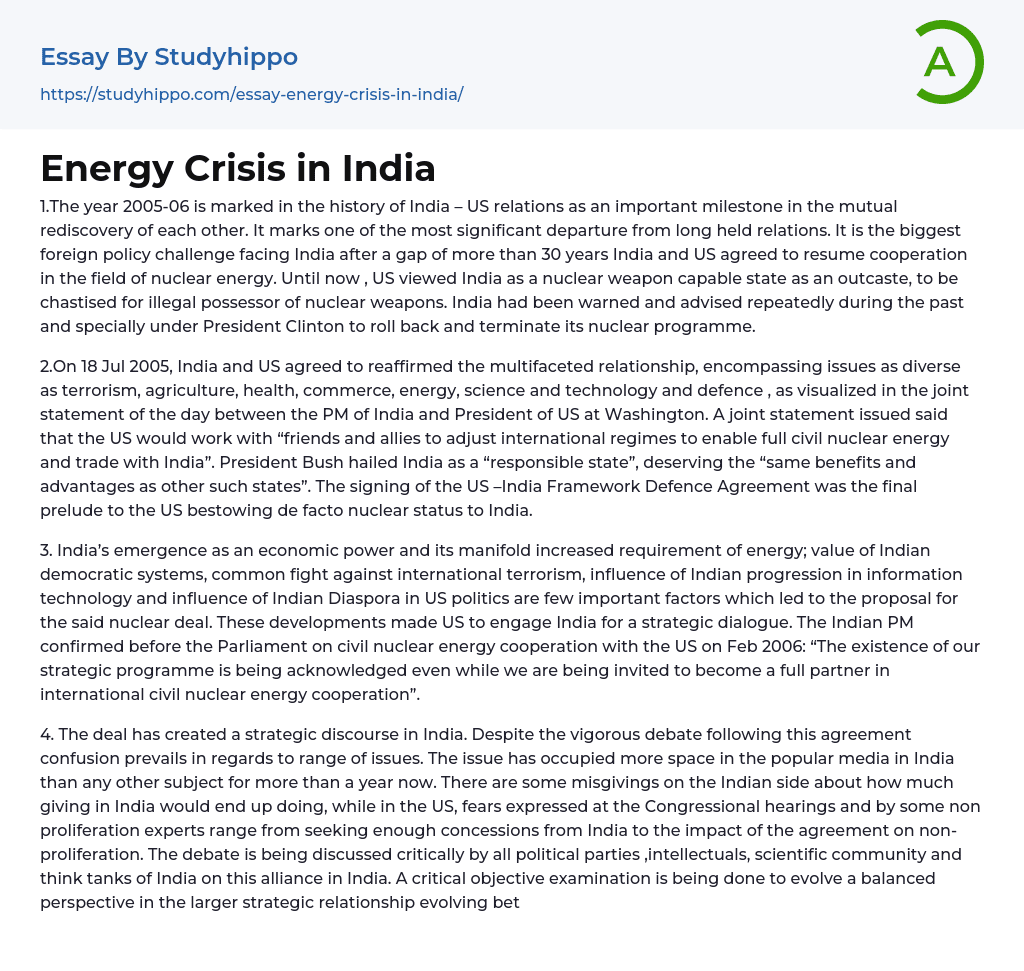2. The period of 2005-06 serves as a pivotal turning point in the historical narrative of India-US relations, signaling a significant shift from prior engagements. This timeframe denotes an important diplomatic policy challenge for India, signifying the first occasion in over thirty years that both nations consented to recommence their nuclear energy collaboration. Before this era, the U.S perceived India as an isolated country with potential nuclear capabilities; a nation accused of illegal possession of such armaments. Multiple warnings and counsel were previously issued to India, particularly during President Clinton's administration, encouraging it to cease its nuclear initiative.
2. On 18th July 2005, a comprehensive partnership encompassing various sectors such as defense, agriculture, health, commerce, energy, science, technology and counter-terrorism was reaffirmed between the United States and India. This bond was fortified in a joint declaration made dur
...ing a meeting held in Washington D.C., attended by the Indian Prime Minister and US President. The statement highlighted America's commitment to work closely with its partners and allies to amend international standards that would allow extensive civil nuclear energy trade with India. President Bush lauded India for its national responsibility and stressed that it should attain benefits akin to those received by other nations of comparable status. The culmination of the US-India Framework Defense Agreement marked the last step before America formally acknowledged India as a de facto nuclear state.
3. Numerous factors have been instrumental in preparing the foundation for the suggested nuclear agreement, such as India's rising economic strength, increasing energy needs, sturdy democratic structures, cooperative counter-terrorism tactics, advances in Information Technology sector and the influence of its diaspora on U.S politics. These elements have facilitated strategic
dialogues between the U.S. and India. In a 2006 parliamentary address concerning civil nuclear energy cooperation with America, India's Prime Minister acknowledged "Our strategic program is gaining recognition as we are invited to participate in international civil nuclear energy cooperation as major partners".
4. The deal has stimulated a critical conversation in India. Despite the enthusiastic debates sparked by this agreement, there remains uncertainty about a multitude of issues. For over a year, it's been the predominant subject in India's mainstream media more than any other matter. Some fears exist within India concerning potential compromises that may need to be made. Conversely, in the U.S., issues brought up at Congressional hearings and by numerous non-proliferation experts range from seeking significant concessions from India to the pact's effect on non-proliferation. This dialogue is being scrutinized extensively by all political groups, intellectuals, scientists, and Indian think tanks regarding this partnership. A vital objective analysis is underway to develop a comprehensive perspective on the growing strategic relationship between both countries.
5.Former U.S. President George W. Bush sanctioned the Henry J Hyde US-India Peaceful Atomic Energy Cooperation Act of 2006 in Washington. He highlighted the civilian nuclear agreement, now codified into law, as a testament to the increasing trust between the two nations, and a tool to fortify their bilateral ties further. “This is a significant milestone for the entire globe. After three decades of operating under a different system, India will now manage its civilian nuclear energy programme following globally accepted benchmarks, making the world a safer place as a result,” he stated. The bill, which represents an adjustment to the 1954-US Atomic Energy Act, won congressional approval.
This will
enable the US to reinstate non-military nuclear ties with India, molded post-India's 1974 Nuclear tests. The deal's functionality will hinge on a distinct 123 agreement. Moreover, India is necessitated to ratify a safeguard pact with the International Atomic Energy (IAEA), whereby the 45-member Nuclear Supplies Group (NSG) needs to modify its rules permitting the global community to engage in nuclear commerce with this country.
- Energy Development essays
- The elements essays
- Voltage essays
- Solar Energy essays
- Nuclear Energy essays
- Alternative Energy essays
- Federal government essays
- Armed Forces essays
- Confederate States Of America essays
- Federal Government Of The United States essays
- Fourteenth Amendment To The United States Constitution essays
- Governance essays
- Parliament essays
- Politics essays
- Jurisdiction essays
- Bureaucracy essays
- Separation Of Powers essays
- Congress essays
- President essays
- United States Congress essays
- Non-Commissioned Officer essays
- Appeal essays
- Revenge essays
- Corporate Governance essays
- Public Service essays
- Income Tax essays
- Supply essays
- Red Cross essays
- Democracy essays
- State essays
- Liberty essays
- Absolutism essays
- Reform essays
- Republic essays
- John Marshall essays
- Bourgeoisie essays
- Developed Country essays
- Elections essays
- International Relations essays
- Left-Wing Politics essays
- Monarchy essays
- Political Corruption essays
- Political Party essays
- Political Science essays
- Sovereign State essays
- United Nations essays
- World Trade Organization essays
- Contras essays
- Dictatorship essays
- Foreign policy essays




